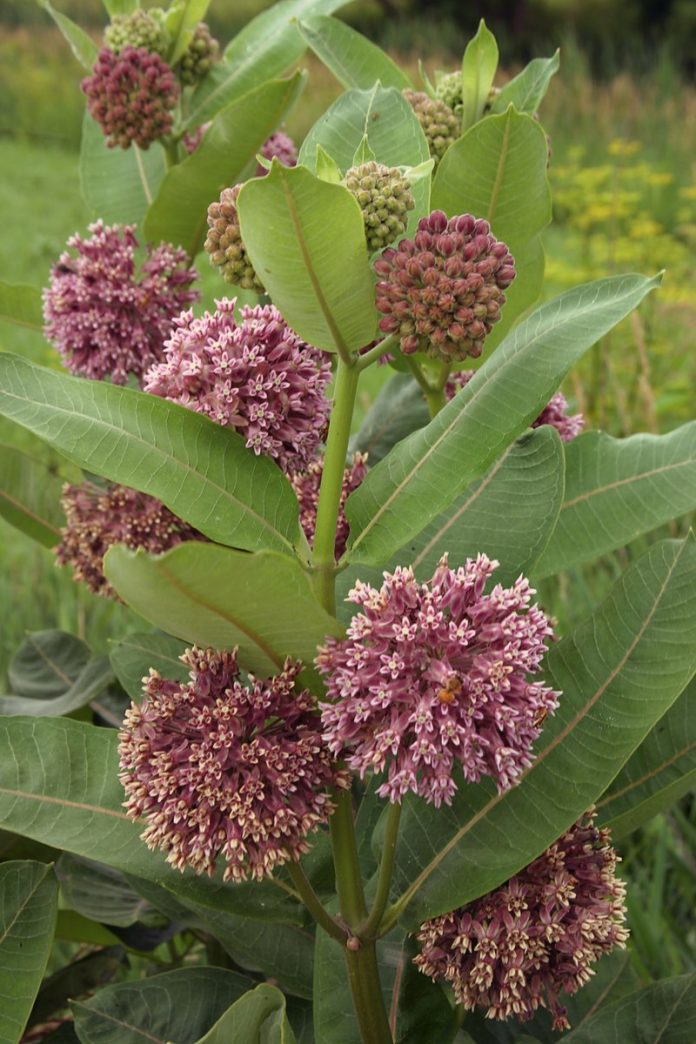Bernadette Vangool
Saskatchewan Perennial Society
By now most people have been alerted to the plight of the monarch butterfly (Danaus plexippus) and naturalists across the US and Canada are urging gardeners to include milkweed in their landscapes. Female monarchs will deposit their eggs on the underside of the leaves of milkweeds. Their larvae, the distinctly striped white yellow and black caterpillars, will feed exclusively on these plants.
All milkweeds (Asclepias), aptly named after Asklepios, the Greek god of medicine, contain cardiac glycoside compounds or cardenolides which are passed on to the monarch, making it unpalatable to predators. Most animals avoid eating milkweeds as they taste bad and they therefore seldom consume lethal quantities.
Across the continent, the increased use of herbicides combined with the increased conversion of grassland to cropland, has resulted in the decline of milkweed, the all important food source for the migratory monarch population. Thus, other than our gardens, milkweed are only prevalent on roadsides, conservation lands and pasture land. A study in Central Nebraska in 2018 found that while deer avoided common milkweed (Asclepias syriaca) and showy milkweed (Asclepias Speciosa), cattle happily grazed them as part of their balanced buffet of grasses, showing no ill effects. The study showed that cattle can safely graze low amounts of milkweed and that control efforts are often unnecessary. (1)
Unfortunately, not all milkweeds are created equal. It has been found that the narrow-leaved varieties, such as whorled milkweed (Asclepias verticillata) which has grass-like leaves that whirl around a main stem, can be detrimental. These milkweeds contain additional neurotoxins, besides the cardenolides, which in small quantities can prove lethal to horses and perhaps cattle as well. In the pasture, grazers can normally avoid these species. The problem occurs when they are served up as hay, and the animals are unable to distinguish it from healthy food. Whorled milkweed is native to south-eastern Saskatchewan. It once grew quite abundantly in the Souris Valley, but the building of the Rafferty dam flooded most of its preferred habitat, so it is now quite rare. Even though seed may be available, because of its high toxicity it is suggested not to grow this variety near livestock and hay land.
To complicate matters, there is tropical milkweed (Asclepias curassavica), also sold as Mexican butterfly weed or bloodflower. A zone 8 to 10 plant, it would be considered an annual in Saskatchewan. It is easy to propagate and can be produced quickly for sale. It has colourful flowers and lush foliage attractive to customers browsing the nurseries. In temperate zones it does not die back in winter and becomes a carrier of Ophryocystis elektroscirrha or OE, a protozoan parasite that travels with the monarch butterfly and is deposited on the leaves. In temperate zones when plants are over-wintered, these parasites build up on the leaves to such an extent that when ingested by the caterpillars, they cause deformities in emerging butterflies. Our native and perennial species of milkweed die back each year, effectively killing off these parasites.
Another reason not to grow these annual species is that they can stay in bloom for a very long period, often till freeze up. Most native species will finish flowering by the end of August or early September, signalling the butterflies to start their trek south. The annual species can thus confuse the monarchs into another breeding season here instead of overwintering in warmer zones. Besides these concerns, climate change has resulted in warmer weather. Warmer weather increases the cardenolide levels in the tropical milkweed, making them toxic to even the butterflies. (2)
Enough doom and gloom, but stay tuned next week to look at many varieties of milkweed that can flourish in your back yard.
(1) Cattle Graze Central US Milkweeds as Much as Grasses, Even Under Patch- Burn-Grazing Management – Science Direct
(2) Tropical Milkweed – A No-Grow by Justin Wheeler – April 2018
This column is provided courtesy of the Saskatchewan Perennial Society (SPS; saskperennial@hotmail.com). Check our website (www.saskperennial.ca) or Facebook page (www.facebook.com/saskperennial) for a list of upcoming gardening events.


